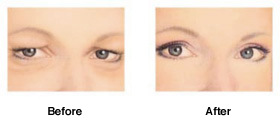Blepharoplasty
Blepharoplasty is both a functional and cosmetic surgical procedure that reshapes the upper or lower eyelid by removing excess tissue, repositioning of tissue, including reinforcement of surrounding muscles. Its high level of patient satisfaction has made it one of the most popular cosmetic procedures today.
Blepharoplasty smoothes puffy eyes, drooping eyelids, and conspicuous folds surrounding the eye by removing excess fat, skin, and muscle from the upper and/or lower eyelid.

Do I need eyelid surgery?
If your eyelids sag, affect or block your vision, or are chronically irritated, blepharoplasty may be for you. Consistently heavy eyelids, tearing watery eyes, or headaches from trying to keep your eyes open may also be treated with eyelid surgery. Blepharoplasty is also suitable for those looking to get rid of bags or loose skin around their eyes.
What should I expect?
There are two different eyelift surgical procedures: upper eyelid (blepharoplasty) and lower eyelid (transconjunctival blepharoplasty). Depending on your needs, your surgeon may conduct one or both of these procedures.
The upper eyelid procedure consists of tiny incisions made along the natural folds of your skin (resulting in inconspicuous or even invisible scars). Excess skin, fatty tissue, and muscle are removed from your upper eyelid, and the muscle around the eye is tightened if necessary.
Transconjunctival blepharoplasty, surgery on the lower eyelid, removes fatty tissue by an incision made on the inside of the eyelid (so no external scarring appears). Occasionally, with an excess of skin or muscle below the eye, a small incision is made just below the lower lash line.
Before surgery:
Your first consultation with your surgeon will help determine the procedures necessary to achieve your desired look. During this meeting, your vision and tear production will be tested, and all medications, allergies, prior surgeries and contact lens use will be discussed. Be sure to ask questions and feel comfortable with the plan you and your surgeon have agreed upon.
Procedure day:
On the day of surgery, arrive early to get checked in and settled. You will be given a local anaesthetic and, if necessary, a mild sedative to help you relax. Once the surgeon has removed the excess fat, skin and muscle in the upper and/or lower eyelids, he will close the incisions with very fine sutures. Surgery typically lasts from one to two hours, depending on the procedures needed.
After surgery:
Be sure to have someone drive you home, as your eyelids may feel tight and sore after surgery. Postoperative discomfort is typically mild, though your surgeon will prescribe pain medication to assist in your healing process. You may experience some bruising and swelling up to two weeks after the procedure, though you should be able to read or watch television after two or three days. You can begin wearing your contact lenses again after about two weeks, though they may feel uncomfortable for a while.
Your surgeon will monitor your healing process closely for the first two weeks following your blepharoplasty. Sutures are removed after about six or seven days, and then makeup or sunglasses can be used to camouflage any temporary bruising. Healing is a gradual process, and scars may remain pink for as long as six months after your procedure. Eventually, scars will fade into thin, nearly invisible white line.
The decision to have blepharoplasty is an important one, so be sure to be well informed prior to any surgery. Consult with the surgeon to discuss any concerns or questions you may have. Blepharoplasty is generally considered a cosmetic procedure, so Medicare and most insurance companies will not pay for the procedure. If your eyelids are affecting your vision, however, Medicare and your insurance may cover the procedure as "medically necessary" surgery.
As one of the most popular cosmetic procedures, blepharoplasty leaves the majority of our patients extremely satisfied with their results. However, there is always a possibility of complications, including infection or slight asymmetry in healing or scarring. We assure that we will give our best effort to achieve the results you desire.
We invite you to contact us for more information.

